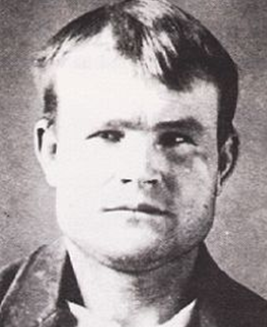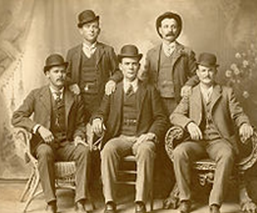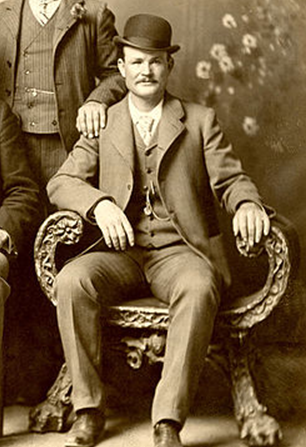
Robert LeRoy Parker (April 13, 1866 – November 6, 1908/1936?), better known as Butch Cassidy,[1] was a notorious American train robber, bank robber, and leader of the Wild Bunch Gang in the American Old West. After pursuing a career in crime for several years in the United States, the pressures of being pursued, notably by the career in crime for several years in the United States, the pressures of being pursued, notably by the Pinkerton Detective Agency, forced him to flee with an accomplice, Harry Alonzo Longabaugh, known as the Sundance Kid, and Longabaugh's girlfriend, Etta Place, first toArgentina and then to Bolivia, where he and Longabaugh were allegedly killed in a shootout in November 1908.
Early life
Robert Leroy Parker was born on April 13, 1866 in Beaver, Utah, to Maximillian Parker and Ann Campbell Gillies, English and Scottish immigrants, respectively, who came to the Utah Territory in the late 1850s.[2] Ann Gillies, the mother of Butch Cassidy was born and lived on Tyneside, Newcastle, North East England, before moving to America with her parents in the 1850s, where she married Butch's father, Maximilian Parker, in Utah.[3] Parker's parents had lived in Victoria Road in Preston, Lancashire, England, and emigrated to escape religious persecution of their Mormon faith.
He was the first of their 13 children. He grew up on their ranch near Circleville, Utah, 346 km (215 mi) south of Salt Lake City, Utah. He left home during his early teens, and while working at a dairy farm, looked up to, and was mentored by Mike Cassidy, a horse thief and cattle rustler. He subsequently worked at several ranches, in addition to a brief stint as a butcher in Rock Springs, Wyoming, when he acquired the nickname "Butch", to which he soon appended the surname Cassidy in honor of his old friend and mentor.
Life as a criminal
1880–1887 — first incidents, becoming a robber
Butch Cassidy's first offense was minor. Around 1880, he journeyed to a clothier's shop in another town only to find the shop closed. He entered the shop and took a pair of jeans and some pie, leaving an closed. He entered the shop and took a pair of jeans and some pie, leaving an IOU promising to pay on his next visit. However, the clothier pressed charges. He was acquitted at a jury trial.
He continued to work on ranches until 1884, when he moved to Telluride, Colorado, ostensibly to seek work but perhaps to deliver stolen horses to buyers. He led a cowboy's life in Wyoming and in Montana, before returning to Telluride in 1887. There he met Matt Warner, the owner of a race horse. The men raced the horse at various events, dividing the winnings between them.winnings between them.
1889–1895 — Early robberies, going to prison
Cassidy, Warner and two of the McCarty Brothers were responsible for the robbery, on June 24, 1889, of the San Miguel Valley Bank in Telluride in which they stole approximately $21,000, after which they fled to the Robbers Roost, a remote hideout in southeastern Utah.
In 1890, Cassidy purchased a ranch near Dubois, Wyoming. This location is across the state from the notorious Hole-in-the-Wall, a natural geological formation which afforded outlaws much welcomed protection and cover, so it is possible that Cassidy's ranching, at which he was never economically successful, was in fact a façade for clandestine activities, perhaps with Hole-in-the-Wall outlaws.[4]
In early 1894, Cassidy became involved romantically with Old West outlaw and rancher Ann Bassett. Bassett's father, rancher Herb Bassett, did business with Cassidy, supplying him with fresh horses and beef. That same year, Cassidy was arrested at Lander, Wyoming, for stealing horses and possibly for running a protection racket among the local ranchers there.
Imprisoned in the state prison in Laramie, Wyoming, he served 18 months of a two-year sentence and was released in January 1896, having promised Governor William Alford Richards that he would not again offend in that state in return for a partial remission of his sentence. Upon his release, he became involved briefly with Ann Bassett's older sister, Josie, and then returned to his involvement with Ann.
1896–1897 — Leaving prison and forming the Wild Bunch

Cassidy's mugshot from the Wyoming Territorial Prison in 1894.

Cassidy is seated on the far right Click a person for more information.
Upon his release he associated himself with a circle of criminals, most notably his closest friend Elzy Lay, Harvey "Kid Curry" Logan, Ben Kilpatrick, Harry Tracy, Will "News" Carver, Laura Bullion, and George Curry, who, together with others, formed a gang known as the Wild Bunch, and with this his criminal activity increased considerably. Although there is some controversy as to how violent the Wild Bunch may or may not have been, there is no definitive historical record of any member of The Wild Bunch being charged with murder.[5]
On August 13, 1896, Cassidy, Lay, Harvey Logan and Bob Meeks[6] robbed the bank at Montpelier, Idaho, escaping with approximately $7,000. Shortly thereafter he recruited Harry Longabaugh, alias "The Sundance Kid", a native of Pennsylvania, into the Wild Bunch.
In early 1897, Cassidy was joined at Robbers Roost by his off and on girlfriend Ann Bassett, Elzy Lay, and Lay's girlfriend Maude Davis. The four hid out there until early April, when Lay and Cassidy sent the women home so that they could plan their next robbery. On April 21, 1897, in the mining town of Castle Gate, Utah, Cassidy and Lay ambushed a small group of men carrying the payroll of the Pleasant Valley Coal Company from the railroad station to their office, stealing a sack containing $7,000 in gold, with which they again fled to the Robbers Roost.
On June 2, 1899, the gang robbed a Union Pacific overland flyer near Wilcox, Wyoming, a robbery that became famous and which resulted in a massive man hunt.[7][8] Many notable lawmen of the day took part in the hunt for the robbers, but they were not found.
During one shootout with lawmen following that robbery, both Kid Curry and George Curry shot and killed Sheriff Joe Hazen. Noted killer for hire and contract employee of the Pinkerton Agency, Tom Horn, obtained information from explosives expert Bill Speck that revealed that they had shot Hazen, which Horn passed on to Pinkerton detective Charlie Siringo. The gang escaped into the Hole-In-The-Wall. Siringo was assigned the task of capturing the outlaw gang. He became friends with Elfie Landusky, who was by then going by the last name Curry alleging that Lonny Curry, Kid Curry's brother, had gotten her pregnant. Through her, Siringo intended to locate the gang.
On July 11, 1899, Lay and others were involved in a train robbery near Folsom, New Mexico, which Cassidy may have planned and may have been directly involved in, which led to a shootout with local law enforcers in which Lay, arguably Cassidy's best friend and closest confidante, killed Sheriff Edward Farr and posseman Henry Love, leading to his imprisonment for life in the New Mexico State Penitentiary.
The Wild Bunch would usually split up following a robbery, heading in different directions, and later reunite at a set location, such as the Hole-in-the-Wall hideout, "Robbers Roost", or MadameFannie Porter's brothel, in San Antonio, Texas. The Hole-in-the-Wall hideout has been assembled at Old Trail Town in Cody, Wyoming. It was built in 1883 by Alexander Ghent.[9]
Failed attempt at amnesty
Perhaps as a consequence of the loss of Lay, Cassidy appears to have approached Governor Heber Wells of Utah, which had joined the Union in 1896, to negotiate an amnesty, but Wells appears to have recoiled from this, advising Cassidy to instead approach the Union Pacific Railroad to persuade them to drop their criminal complaints against him. This meeting never took place, however, possibly because of bad weather. The Union Pacific Railroad, under chairman E. H. Harriman, subsequently attempted to meet with Cassidy, through his old ally Matthew Warner, who had been released from prison. On August 29, 1900, however, Cassidy, Longabaugh and others robbed a Union Pacific train near Tipton, Wyoming, violating Cassidy's earlier promise to the governor of Wyoming not to offend again in that state, and effectively ending the prospects for amnesty.
Meanwhile, on February 28, 1900, lawmen attempted to arrest Kid Curry's brother, Lonny Curry, at his aunt's home. Lonny was killed in the shootout that followed, and his cousin Bob Lee was arrested for rustling and sent to prison in Wyoming. On March 28, Kid Curry and Bill Carver were pursued by a posse out of St. Johns, Apache County, Arizona, after being identified as passing notes possibly from the Wilcox, Wyoming, robbery. The posse caught up with them and engaged them in a shootout, during which Deputy Andrew Gibbons and Deputy Frank LeSueur were killed. Carver and Curry escaped. On April 17, George Curry was killed in a shootout with Grand County, Utah, Sheriff John Tyler and Deputy Sam Jenkins. On May 26, Kid Curry rode into Moab, Utah, and killed both Tyler and Jenkins in a brazen shootout, in retaliation for their killing of George Curry, and for the death of his brother Lonny.
Cassidy, Longabaugh, and Bill Carver traveled to Winnemucca, Nevada, where on September 19, 1900, they robbed the First National Bank of Winnemucca, Nevada of $32,640. In December, Cassidy posed in Fort Worth, Texas for the now-famous Fort Worth Five Photograph,[10] which depicts Parker, Longabaugh, Harvey Logan (alias Kid Curry), Ben Kilpatrick and William Carver. The Pinkerton Detective Agency obtained a copy of the photograph and began to use it for its latest wanted posters.
Kid Curry rejoined the gang, and together with Cassidy and Longabaugh they robbed a Great Northern train near Wagner, Montana. This time, they took over $60,000 in cash. Again the gang split up, and gang member Will Carver was killed by one pursuing posse led by Sheriff Elijah Briant. On December 12, 1901, gang member Ben Kilpatrick was captured in Knoxville, Tennessee, along with Laura Bullion. On December 13, during a shootout with lawmen, Kid Curry killed Knoxville policemen William Dinwiddle and Robert Saylor, and escaped. Curry, despite being pursued by Pinkerton agents and other law enforcement officials, returned to Montana, where he shot and killed rancher James Winters, responsible for the killing of his brother Johnny years before.[11]
1901 — travel to South America
Cassidy and Longabaugh then fled east to New York City, and on February 20, 1901, with Ethel "Etta" Place, Longabaugh's female companion, they departed to Buenos Aires, Argentina, aboard the British steamer Herminius, Cassidy posing as James Ryan, Place's fictional brother. There he settled with Longabaugh and Place in a four-room log cabin on a 15,000-acre (61 km2) ranch that they purchased on the east bank of the Rio Blanco near Cholila, Chubut province in west-central Argentina, near the Andes.
1905 and his last years — his biggest robbery, evading the law
On February 14, 1905, two English-speaking bandits, who may have been Cassidy and Longabaugh, held up the Banco de Tarapacá y Argentino in Río Gallegos, 700 miles (1,100 km) south of Cholila, near the Strait of Magellan. Escaping with a sum that would be worth at least US $100,000 today, the pair vanished north across the bleak Patagonian steppes.
On May 1, the trio sold the Cholila ranch because the law was beginning to catch up with them. The Pinkerton Agency had known their location for some time, but the rainy season had prevented their assigned agent, Frank Dimaio, from traveling there and making an arrest. Governor Julio Lezana had then issued an arrest warrant, but before it could be executed Sheriff Edward Humphreys, a Welsh Argentine who was friendly with Cassidy and enamored of Etta Place, tipped them off.
The trio fled north to San Carlos de Bariloche where they embarked on the steamer Condor across Nahuel Huapi Lake and into Chile. However by the end of that year they were again back in Argentina; on December 19, Cassidy, Longabaugh, Place and an unknown male (possibly Harvey Logan) took part in the robbery of the Banco de la Nacion in Villa Mercedes, 400 miles (640 km) west of Buenos Aires, taking 12,000 pesos. Pursued by armed lawmen, they crossed the Pampas and the Andes and again reached the safety of Chile.
On June 30, 1906, Etta Place decided that she had had enough of life on the run and was escorted back to San Francisco by Longabaugh. Cassidy, under the alias James "Santiago" Maxwell, obtained work at the Concordia Tin Mine in the Santa Vera Cruz range of the central Bolivian Andes, where he was joined by Longabaugh upon his return. Ironically, their main duties included guarding the company payroll. Still wanting to settle down as a respectable rancher, Cassidy, late in 1907, made an excursion with Longabaugh to Santa Cruz, a frontier town in Bolivia's eastern savannah.




















